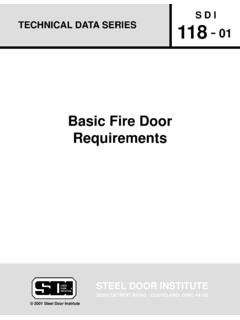Transcription of Keying Systems and Nomenclature - ASSA ABLOY
1 Keying Systems AND Nomenclature FOREWORD Keying Procedures, Systems , and Nomenclature was first published in 1965, revised in 1969, 1975 and again in 1978. It introduced a procedural system of Keying terminology radically different from that commonly used prior to 1965. The need for standard terminology was clear but the acceptance of the new system was slow. Manufacturers, Distributors, Building Owners, and Operators were frustrated over the use of various and differing terms.
2 Among those using the terms, different meanings and interpretations were applied. As a result, errors were made, and frequent correspondence occurred between manufacturers and distributors, seeking clarification. The consumer sometimes had a sketchy understanding of the key system he had purchased. Since its inception, the procedures outlined in this manual have been taught at the DHI Technical Programs and the results have been gratifying. The use and understanding of the system is now close to industry wide, and the authors of the previous editions should take pride in the results.
3 There are still some misapplications and misunderstandings of the system and it is the purpose of this edition to clarify the system to avoid misunderstanding. With this in mind, text and format changes have been made with the aim of introducing criteria in their order of complexity, to make the manual an even better instructional tool for those progressing through basic, intermediate, and advanced study of the subject. Since the manual does not cover actual Keying procedures, the title of the manual has been changed.
4 For those interested in the actual techniques of Keying or the mathematics of setting up a key system, many fine books and publications are offered by the lock-smithing industry. Robert Perry, AHC/CDC John R. "Jake" Dalbert. AHC Richard Hudnut, DAHC Copyright 1989 by the Door and Hardware Institute First Printing 1965 Revised 1969, 1975, 1978 Reprinted April 1999 INDEX page: FOREWORD .. 1 INDEX .. 2 CHAPTER 1 Planning a Key System .. 3 Basic Facts of Key Systems Steps to Structure a Key System CHAPTER 2 System Theory.
5 5 Basic Levels of Keying Key and Cylinder Coding System CHAPTER 3 Level One System .. 7 No Master Key CHAPTER 4 Level Two System .. 8 Single Master Key System Exceptions: Omitting the master key Cross Keying CHAPTER 5 Level Three System .. 10 Grand Master Key System Exceptions: Omitting one or more levels Cross Keying More than 23 master keys Leading Zero's CHAPTER 6 Level Four System .. 11 Great Grand Master Key System Exceptions: Omitting one or more levels Cross Keying CHAPTER 7 School Key System Guidelines .. 12 CHAPTER 8 Hospital Key System Guidelines .. 14 CHAPTER 9 Hotel Key System Guidelines.
6 15 CHAPTER 10 Office Building Key System Guidelines .. 17 CHAPTER 11 Multiplex Key Systems .. 18 CHAPTER 12 Key Control Systems .. 19 Planning a Key Control System Tips for Setting Up Systems Lock and Key Survey CHAPTER 13 Maintenance of Key Systems .. 21 CHAPTER 14 The Key Conference .. 22 Setting up the Conference Preparing for the Conference During the Conference The Work Sheet CHAPTER 15 Key System Limitations .. 25 Key Depths Mathematical Limitations Multiples of 4 CHAPTER 16 Recommended Standard Definitions .. 27 3 CHAPTER 1 PLANNING A KEY SYSTEM "Hardware consultants render one of their most useful services by designing a practical and efficient Keying system for a facility.
7 Because the principles of Keying are not understood by those outside the field of locks, a consultant's services are most valuable in guiding the organization of Keying so it will: 1. Function properly 2. Be easy to understand 3. Be practical enough to survive years of usage 4. Provide the security required by the user BASIC FACTS OF KEY Systems The following basic facts apply regardless of the manufacturer, type of cylinder, or key involved in the system: Security Is Inversely Proportional to Convenience A cylinder operated by a single key is most secure.
8 Each additional key operating the same cylinder increases the number of shear lines. This reduces the security of the cylinder by making it easier to pick or be opened by unauthorized keys. Durability Is Affected by the Level of Keying A cylinder operated by a single key lasts longest. Each additional key operating the same cylinder requires more master pins of different increments. The number of master pins increase with each successive level of Keying . This causes greater wear and increases the chances of malfunction of the cylinder.
9 There are Limitations There are a limited number of change, master, and grand master keys that can be established within a Keying system. This limitation is physical and mathematical in nature and exists within all Systems . Systems designed to be expanded the least are generally the most secure. It is important to be realistic in establishing the degree of future expansion. (See Chapter 15 for a better understanding of a system's limitations). Keys Relate to Each Other The keys in a Keying system relate to each other and to the system as a whole.
10 This relationship restricts Keying options and the flexibility of the system design. Keep It Simple The more complicated the design of the Keying system, the shorter its usable life. Key a building to perform its function. Do not key it to individuals on an organization chart. Personnel/ People relationships and organizations change rapidly. Building functions survive for many years. An intricate system, misunderstood by the owner, usually degenerates quickly. The result is usually that everyone ends up with a master key. Break Up Very Large Systems It is unwise to tie too much together under one "top" master key.










